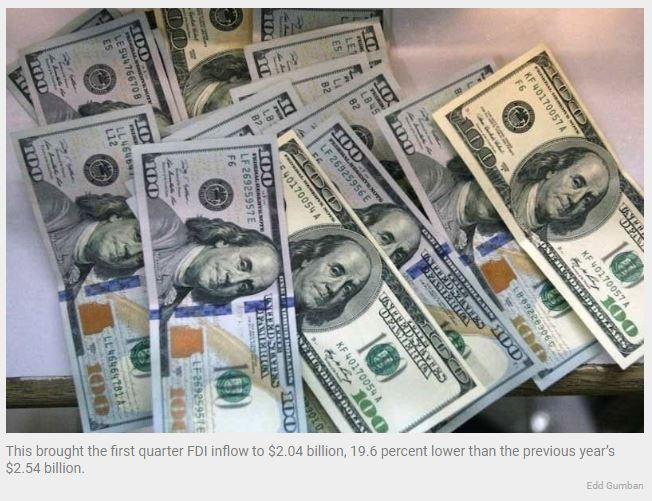Philippines: FDI inflow drops 19.6% in Q1
MANILA, Philippines — The inflow of foreign direct investments (FDI) dropped by 30.7 percent to $548 million in March from $792 million in the same month last year amid investor concerns over subdued global growth prospects, according to the Bangko Sentral ng Pilipinas (BSP).
This brought the first quarter FDI inflow to $2.04 billion, 19.6 percent lower than the previous year’s $2.54 billion.
“The said decline resulted from lower net inflows across all major FDI components amid investor concerns over subdued global growth prospects,” the BSP.
Investments in debt instruments, consisting mainly of intercompany borrowing between foreign direct investors and their subsidiaries or affiliates in the Philippines, fell by 37.2 percent to $389 million in March from $620 million a year ago.
Total reinvestment of earnings dipped slightly to $62 million in March from $65 million in the same month last year.
On the other hand, equity other than reinvestment of earnings decreased by 11.7 percent to $94 million in March from $106 million in the same period last year.
Equity infusions from Singapore, Japan and the United States slipped by 2.5 percent to $115 million in March from $118 million in the same month last year. The inflows were channeled into manufacturing, information and communication as well as real estate.
On the other hand, equity withdrawals surged by 80.3 percent to $21 million from $12 million.
Michael Ricafort, chief economist at Rizal Commercial Banking Corp., attributed the decline in FDI inflow in March to higher market volatility in terms of increased risk aversion amid uncertainties due to some US regional bank failures, including Silicon Valley Bank, Signature Bank and First Republic Bank.
Investment in debt instruments fell by 22.1 percent to $1.58 billion from January to March compared to $2.03 billion in the same period last year, while reinvestment of earnings slipped by 0.7 percent to $202 million from $204 million.
On the other hand, equity inflows from Japan, Singapore and the US grew by 6.9 percent to $377 million from $352 million, while outflow almost tripled to $115 million from $42 million.
“For the coming months, net FDIs could pick up further amid easing trend in inflation and eventually interest rates, measures to further reopen the economy with no more restrictions as a policy priority, the Philippine economic growth expected to be among the fastest in the region, the country’s attractive demographics, economic reopening of China since December, investment commitments obtained by the administration from overseas visits/trips in recent months,” Ricafort said.
Inflation eased to a 12-month low of 6.1 percent in May from 6.6 percent in April after a year-long tightening cycle by the Monetary Board that saw key policy rates rise by a cumulative 425 basis points since May last year.
The inflation downtrend and the robust gross domestic product growth of 6.4 percent in the first quarter of the year, although slower than the fourth quarter’s 7.1 percent and the eight percent expansion in the first quarter of last year, allowed the BSP to take a prudent pause by keeping interest rates unchanged on May 18.
Ricafort said the country’s membership in the Regional Comprehensive Economic Partnership, the world’s biggest free trade agreement led by China, would help attract more FDI to make the country a production and marketing base, as well as an access point to bigger export markets of the other RCEP member countries in the region.
In 2022, the Philippines managed to exceed its FDI inflow target of $8.5 billion despite 23.2-percent plunge in net inflow to $9.2 billion from an all-time high of $11.98 billion in 2021.
The BSP sees the net inflow of FDI rising to $11 billion this year and further to $12 billion next year.
Source: https://www.philstar.com/business/2023/06/14/2273624/fdi-inflow-drops-196-q1


 English
English




